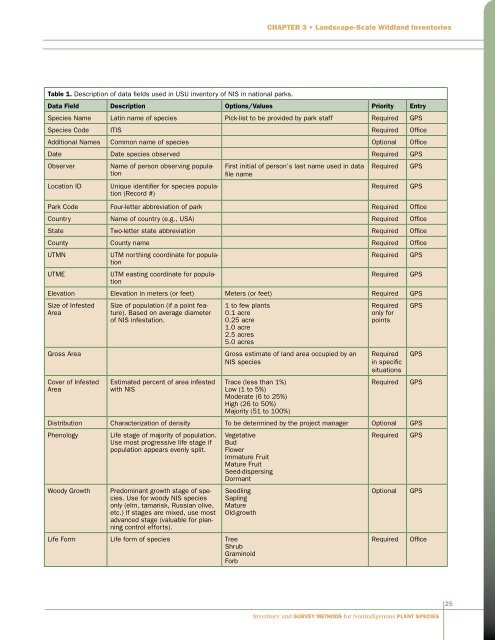Inventory and Survey Methods for Nonindigenous Plant Species (PDF)
Inventory and Survey Methods for Nonindigenous Plant Species (PDF)
Inventory and Survey Methods for Nonindigenous Plant Species (PDF)
- No tags were found...
You also want an ePaper? Increase the reach of your titles
YUMPU automatically turns print PDFs into web optimized ePapers that Google loves.
Chapter 3 • L<strong>and</strong>scape-Scale Wildl<strong>and</strong> InventoriesTable 1. Description of data fields used in USU inventory of NIS in national parks.Data Field Description Options/Values Priority Entry<strong>Species</strong> Name Latin name of species Pick-list to be provided by park staff Required GPS<strong>Species</strong> Code ITIS Required OfficeAdditional Names Common name of species Optional OfficeDate Date species observed Required GPSObserverLocation IDName of person observing populationUnique identifier <strong>for</strong> species population(Record #)First initial of person’s last name used in datafile nameRequiredRequiredPark Code Four-letter abbreviation of park Required OfficeCountry Name of country (e.g., USA) Required OfficeState Two-letter state abbreviation Required OfficeCounty County name Required OfficeUTMNUTMEUTM northing coordinate <strong>for</strong> populationUTM easting coordinate <strong>for</strong> populationRequiredRequiredElevation Elevation in meters (or feet) Meters (or feet) Required GPSSize of InfestedAreaGross AreaCover of InfestedAreaSize of population (if a point feature).Based on average diameterof NIS infestation.Estimated percent of area infestedwith NIS1 to few plants0.1 acre0.25 acre1.0 acre2.5 acres5.0 acresGross estimate of l<strong>and</strong> area occupied by anNIS speciesTrace (less than 1%)Low (1 to 5%)Moderate (6 to 25%)High (26 to 50%)Majority (51 to 100%)Requiredonly <strong>for</strong>pointsRequiredin specificsituationsRequiredDistribution Characterization of density To be determined by the project manager Optional GPSPhenologyWoody GrowthLife stage of majority of population.Use most progressive life stage ifpopulation appears evenly split.Predominant growth stage of species.Use <strong>for</strong> woody NIS speciesonly (elm, tamarisk, Russian olive,etc.) If stages are mixed, use mostadvanced stage (valuable <strong>for</strong> planningcontrol ef<strong>for</strong>ts).VegetativeBudFlowerImmature FruitMature FruitSeed-dispersingDormantSeedlingSaplingMatureOld-growthLife Form Life <strong>for</strong>m of species TreeShrubGraminoidForbRequiredOptionalRequiredGPSGPSGPSGPSGPSGPSGPSGPSGPSOffice<strong>Inventory</strong> <strong>and</strong> <strong>Survey</strong> <strong>Methods</strong> <strong>for</strong> <strong>Nonindigenous</strong> <strong>Plant</strong> <strong>Species</strong>25
















